This series highlights aspects of my experience self-publishing The Alexandria Project. If you'd like to read the book this series is based on, you can read the first three chapters for free here.
 Last week I identified the different types of Print on Demand (POD) publishers that are active in the market today and provided tips on how to decide which type would best meet your needs. Before we go on to talk about how to select a specific publisher, it's worth pausing to look more deeply into what each type of POD publisher actually does, and how it makes its money.
Last week I identified the different types of Print on Demand (POD) publishers that are active in the market today and provided tips on how to decide which type would best meet your needs. Before we go on to talk about how to select a specific publisher, it's worth pausing to look more deeply into what each type of POD publisher actually does, and how it makes its money.
Why? Because knowing what a POD publisher wants to get out of your partnership makes it easier for you to pick one where your interests and theirs will most closely align. That's what you want, because if the POD publisher wins, then you will as well.
This series highlights aspects of my experience self-publishing The Alexandria Project. If you'd like to read the book this series is based on, you can read the first three chapters for free here.
Like just about every other step in self-publishing a book, researching and selecting a print on demand (POD) publisher can be a time-consuming and even bewildering experience. The problem arises not from a lack of choices, but just the opposite. Today, there are scores of publishers to choose from, with significant differences among them in business model, cost, speed, quality and reputation. The challenge is therefore to figure out which one is just right you.
The first step in that process is to understand the high-level differences between the alternatives available. At the highest level of categorization, there are currently three models from which to choose:
This series highlights aspects of my experience self-publishing The Alexandria Project. If you'd like to read the book this series is based on, you can read the first three chapters for free here.
 If you are of a certain age (and I, most regrettably, am definitely of a certain age), a book means a certain thing, and that is this: something that you can hold in your hands, keep on a shelf, pack up and carry in a box in move after move (after move, after move…), and generally treasure for life, if it’s a good read or a valued resource. Kept indoors and absent a natural disaster, it can – and does – live on for centuries, always there, patiently waiting to be discovered anew, generation after generation.
If you are of a certain age (and I, most regrettably, am definitely of a certain age), a book means a certain thing, and that is this: something that you can hold in your hands, keep on a shelf, pack up and carry in a box in move after move (after move, after move…), and generally treasure for life, if it’s a good read or a valued resource. Kept indoors and absent a natural disaster, it can – and does – live on for centuries, always there, patiently waiting to be discovered anew, generation after generation.
It should therefore come as no surprise that the book I wrote last year, The Alexandria Project, will soon be available in tangible as well as eBook form. This is not to say that this makes a terrific amount of sense, viewed from any rational economic point of view. After all, it’s not likely that any bookstore will ever stock it. Moreover, because of costs of production, it’s also not likely that many people will buy it in soft cover, as compared to electronic form, let alone hardcover.
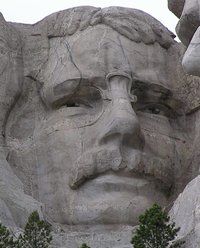 Man's ability to affect the land is all too evident in these times of climate change, pollution and habitat destruction. Happily, the landscape can change man as well.
Man's ability to affect the land is all too evident in these times of climate change, pollution and habitat destruction. Happily, the landscape can change man as well.
The weather finally broke last night, dropping 30 degrees by dawn, and thanks be for that. The night before I had camped in the Sheyenne National Grasslands, heavy with heat and humidity. But the next day it was pleasantly cool (upper 60s), albeit overcast rather than sunny.
Nor was this the only change. It took over 2400 driving miles to finally leave the Eastern, and then Midwestern terrain behind, but today I reached the beginnings of what I think of as the West. More than anything else, in my mind that means “dry.” For the last 800 miles, the landscape had been primarily flat, lush - and transitionally post-glacial. That last factor means an area where the great ice sheets completed their periodic southward pulses, dumping rich, black earth born of thousands of miles of ice grinding down stone, some deposited by glacial steams, and other as windblown “loess” – very fine mineral particles.
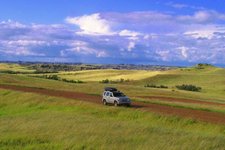 In 2001, I took a one month solo cross country trip, driving from Massachusetts across the Northeast, the Midwest, and then the prairie states, until I reached what we generally think of as “the West” – the land of canyons and buttes, deserts and mesas. Once there, I spent the rest of the time backpacking in the canyonlands of Utah, and then meandering North on dirt roads until I reached Glacier National Park, in the Northwest corner of Montana. After that, I zigzagged back East until I reached the Mississippi. Then, it was just a straight highway shot till I arrived back home once again. It was during that trip that I began writing in earnest, although I haven’t (yet) posted anything from that journey to the Web.
In 2001, I took a one month solo cross country trip, driving from Massachusetts across the Northeast, the Midwest, and then the prairie states, until I reached what we generally think of as “the West” – the land of canyons and buttes, deserts and mesas. Once there, I spent the rest of the time backpacking in the canyonlands of Utah, and then meandering North on dirt roads until I reached Glacier National Park, in the Northwest corner of Montana. After that, I zigzagged back East until I reached the Mississippi. Then, it was just a straight highway shot till I arrived back home once again. It was during that trip that I began writing in earnest, although I haven’t (yet) posted anything from that journey to the Web.
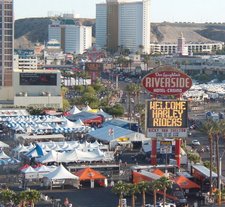 It was an interesting trip, in all, providing a cascade of often starkly diverse images. How varied a range? On the natural grandeur list, I would add spectacular sunsets, wildernesses of soaring, broken redrock, and broad vistas of pristine desert.
And at the opposite end of the spectrum, I might begin with the sights that greeted me when I crossed the Colorado early in the trip, and threaded my way through the 27th Annual Laughlin River Run, a meet that draws over 40,000 leather-clad, mostly aging bikers to what Motorcycle-usa.com calls, “one of the more popular events on the West Coast rally scene, packing bikini contests, custom bike shows, demo rides, poker runs, freak shows and tattoo contests into four-days of 24/7 fun.” I can attest to the fact that it also packs in what is presumably one of the largest assemblages of multi-story, inflatable Jim Beam bottle and Budweiser can replicas to be found anywhere in one place.
It was an interesting trip, in all, providing a cascade of often starkly diverse images. How varied a range? On the natural grandeur list, I would add spectacular sunsets, wildernesses of soaring, broken redrock, and broad vistas of pristine desert.
And at the opposite end of the spectrum, I might begin with the sights that greeted me when I crossed the Colorado early in the trip, and threaded my way through the 27th Annual Laughlin River Run, a meet that draws over 40,000 leather-clad, mostly aging bikers to what Motorcycle-usa.com calls, “one of the more popular events on the West Coast rally scene, packing bikini contests, custom bike shows, demo rides, poker runs, freak shows and tattoo contests into four-days of 24/7 fun.” I can attest to the fact that it also packs in what is presumably one of the largest assemblages of multi-story, inflatable Jim Beam bottle and Budweiser can replicas to be found anywhere in one place.
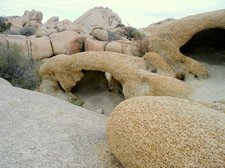 The southwestern landscape hosts a variety of signature geologic forms, some of which have become iconic as the backdrops for countless western movies. If you should find yourself channel surfing late tonight, a single frame of a mesa, butte, spire or hoodoo will instantly lock you on to the genre, even before the dusty characters ride into view.
The southwestern landscape hosts a variety of signature geologic forms, some of which have become iconic as the backdrops for countless western movies. If you should find yourself channel surfing late tonight, a single frame of a mesa, butte, spire or hoodoo will instantly lock you on to the genre, even before the dusty characters ride into view.
The desert rock garden is a less well known type, but it will be familiar to anyone who has spent any time knocking about the southwest, and around Arizona in particular. Unlike the angular, striated spires and hoodoos that erode out of sedimentary formations, rock gardens are more often volcanic in origin than not, usually granitic, and rounded in form, characteristically resembling enormous blowups of the sand dribbles that a child makes at the beach by allowing a slurry of water and sand to slip through her fingers.
 Long-time readers will know that whenever I can, I disappear into the desert for as long as I can. Often, the opportunity arises to cadge a lift out west on the back of a business trip, and so it is that I write this in northwestern Arizona a couple days after spending a day in a conference room buried deep within the bowels of the raucus, random, blaring, unworldly nonsense that is otherwise known as the Mandalay Bay Casino and Resort, Las Vegas, Nevada.
Long-time readers will know that whenever I can, I disappear into the desert for as long as I can. Often, the opportunity arises to cadge a lift out west on the back of a business trip, and so it is that I write this in northwestern Arizona a couple days after spending a day in a conference room buried deep within the bowels of the raucus, random, blaring, unworldly nonsense that is otherwise known as the Mandalay Bay Casino and Resort, Las Vegas, Nevada.
Some of the nonsense worked to my favor, or at least amusement, as my $143.95 room was somehow traded up into a penthouse suite on the 62nd floor of the hotel – a suite that was bigger than the first floor of my admittedly small house, with 18 foot ceilings, a wall of glass behind motorized drapes, bar, living room, two bathrooms (one palatial), four flat screen TV sets (more than I have owned of any type in my entire life), and no coffee maker.
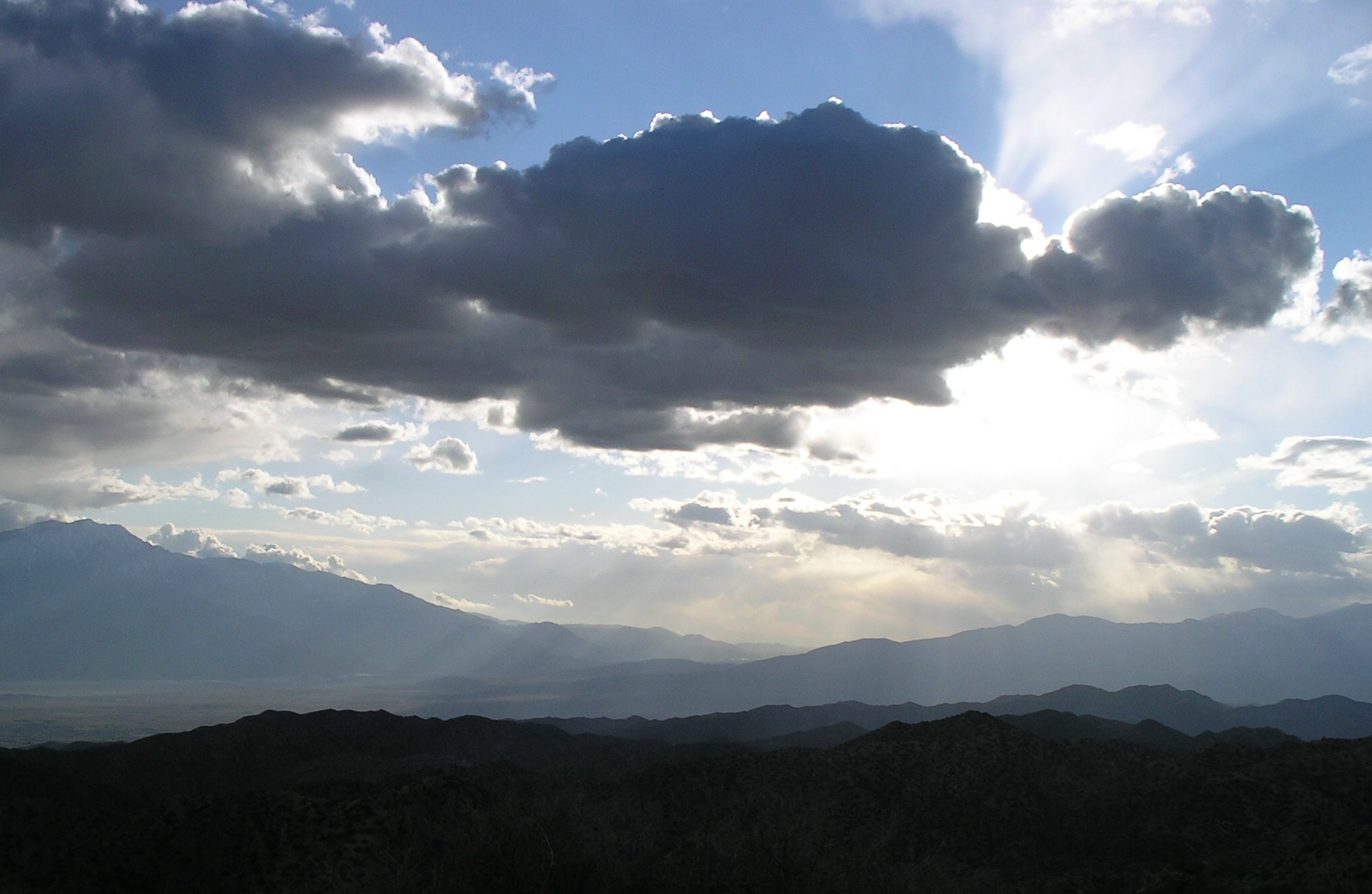 My first day back in the desert, a brisk wind was blowing. In the ordinary course, I would expect that its strength would decline with the sun. And so, rather than looking for a protected cove among the rocks to camp, I shopped for the best view instead. The view delivered nicely, and I enjoyed watching the sunset fade into darkness until the rapidly falling temperature sent me to bed. True to form, the wind abated.
My first day back in the desert, a brisk wind was blowing. In the ordinary course, I would expect that its strength would decline with the sun. And so, rather than looking for a protected cove among the rocks to camp, I shopped for the best view instead. The view delivered nicely, and I enjoyed watching the sunset fade into darkness until the rapidly falling temperature sent me to bed. True to form, the wind abated.
But only for a time. Around midnight, a front moved in from the west, and with it came the wind. Soon it was gusting 30 and 40 miles per hour, rushing by and rattling my ground cloth between the tent stakes I had driven to hold it down.On each downbeat, the edge of the ground cloth would scoop up a scatter of grit. And on each upbeat, it would rain those particles down like sleet on my head, causing me to pull the top of my mummy bag ever more tightly down over my face. But as the wind rose, the half moon set, and with the fading of its light the constellations blazed forth. Orion shone almost directly overhead, and was soon joined by the Pleiades, the Milky Way, and numberless points of light in between.
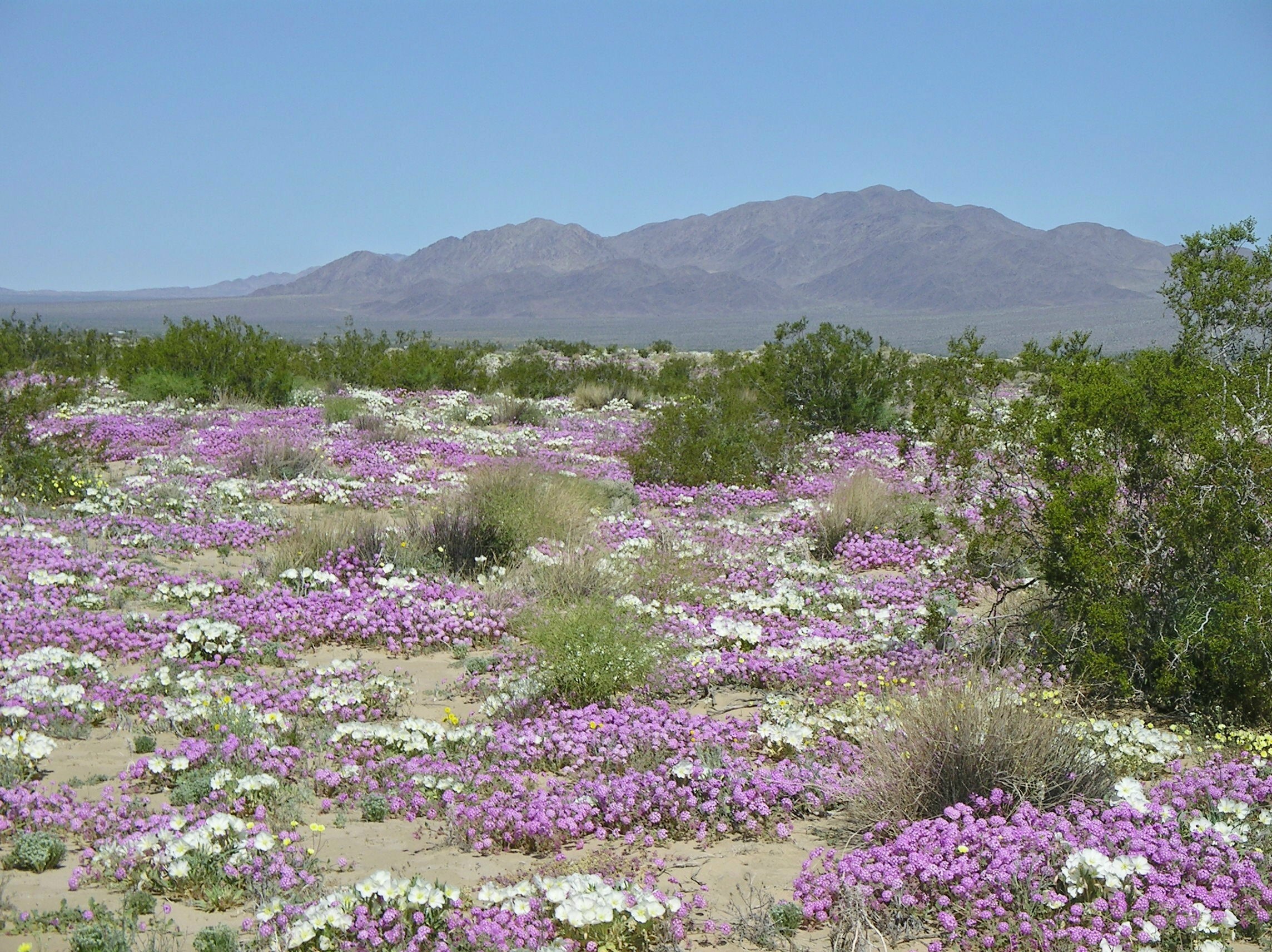 Spring, of course, is the premier time to be in the desert. That’s when all that lives and was grey begins to blush with green, and when the cactus blooms. It’s when the normally drab as dishwater creosote bushes that stretch on for entire states at a time become enpixalated with tiny yellow flowers nestled amid new green leaves no larger than a bee's wing. And most memorably, that’s when the seeds of annuals sprout throw rugs of purple, white, orange and yellow in washes, sandy bottom lands, and other places moist enough to germinate seeds deposited a year, a decade, even twenty-five years before.
Spring, of course, is the premier time to be in the desert. That’s when all that lives and was grey begins to blush with green, and when the cactus blooms. It’s when the normally drab as dishwater creosote bushes that stretch on for entire states at a time become enpixalated with tiny yellow flowers nestled amid new green leaves no larger than a bee's wing. And most memorably, that’s when the seeds of annuals sprout throw rugs of purple, white, orange and yellow in washes, sandy bottom lands, and other places moist enough to germinate seeds deposited a year, a decade, even twenty-five years before.
When to arrive at a given part of the desesrt depends on many things. Altitude will play its part, as will, most crucially, how much rain has fallen over how long a period during the winter months. And also on what you wish to see, as different types of plants have their respective seasons to flower, and not all of these overlap. As a generality, for annuals, come early. For cactus, come late.
Life and the exigencies of earning a living being what they are, my arrival in the Colorado and Mohave deserts of southern California had all to do with opportunity and little to do with floral optimization. I had agreed to speak at a couple of open source conferences in San Francisco that conveniently fell about a week apart, and that provided a reasonable excuse to hold over and head out.
 Last week I identified the different types of Print on Demand (POD) publishers that are active in the market today and provided tips on how to decide which type would best meet your needs. Before we go on to talk about how to select a specific publisher, it's worth pausing to look more deeply into what each type of POD publisher actually does, and how it makes its money.
Last week I identified the different types of Print on Demand (POD) publishers that are active in the market today and provided tips on how to decide which type would best meet your needs. Before we go on to talk about how to select a specific publisher, it's worth pausing to look more deeply into what each type of POD publisher actually does, and how it makes its money.  If you are of a certain age (and I, most regrettably, am definitely of a certain age), a book means a certain thing, and that is this: something that you can hold in your hands, keep on a shelf, pack up and carry in a box in move after move (after move, after move…), and generally treasure for life, if it’s a good read or a valued resource. Kept indoors and absent a natural disaster, it can – and does – live on for centuries, always there, patiently waiting to be discovered anew, generation after generation.
If you are of a certain age (and I, most regrettably, am definitely of a certain age), a book means a certain thing, and that is this: something that you can hold in your hands, keep on a shelf, pack up and carry in a box in move after move (after move, after move…), and generally treasure for life, if it’s a good read or a valued resource. Kept indoors and absent a natural disaster, it can – and does – live on for centuries, always there, patiently waiting to be discovered anew, generation after generation. Man's ability to affect the land is all too evident in these times of climate change, pollution and habitat destruction. Happily, the landscape can change man as well
Man's ability to affect the land is all too evident in these times of climate change, pollution and habitat destruction. Happily, the landscape can change man as well In 2001, I took a one month solo cross country trip, driving from
In 2001, I took a one month solo cross country trip, driving from  It was an interesting trip, in all, providing a cascade of often starkly diverse images. How varied a range? On the natural grandeur list, I would add spectacular sunsets, wildernesses of soaring, broken redrock, and broad vistas of pristine desert.
And at the opposite end of the spectrum, I might begin with the sights that greeted me when I crossed the Colorado early in the trip, and threaded my way through the 27th Annual Laughlin River Run, a meet that draws over 40,000 leather-clad, mostly aging bikers to what
It was an interesting trip, in all, providing a cascade of often starkly diverse images. How varied a range? On the natural grandeur list, I would add spectacular sunsets, wildernesses of soaring, broken redrock, and broad vistas of pristine desert.
And at the opposite end of the spectrum, I might begin with the sights that greeted me when I crossed the Colorado early in the trip, and threaded my way through the 27th Annual Laughlin River Run, a meet that draws over 40,000 leather-clad, mostly aging bikers to what  The southwestern landscape hosts a variety of signature geologic forms, some of which have become iconic as the backdrops for countless western movies. If you should find yourself channel surfing late tonight, a single frame of a mesa, butte, spire or hoodoo will instantly lock you on to the genre, even before the dusty characters ride into view.
The southwestern landscape hosts a variety of signature geologic forms, some of which have become iconic as the backdrops for countless western movies. If you should find yourself channel surfing late tonight, a single frame of a mesa, butte, spire or hoodoo will instantly lock you on to the genre, even before the dusty characters ride into view. Long-time readers will know that whenever I can, I disappear into the desert for as long as I can. Often, the opportunity arises to cadge a lift out west on the back of a business trip, and so it is that I write this in northwestern Arizona a couple days after spending a day in a conference room buried deep within the bowels of the raucus, random, blaring, unworldly nonsense that is otherwise known as the Mandalay Bay Casino and Resort, Las Vegas, Nevada
Long-time readers will know that whenever I can, I disappear into the desert for as long as I can. Often, the opportunity arises to cadge a lift out west on the back of a business trip, and so it is that I write this in northwestern Arizona a couple days after spending a day in a conference room buried deep within the bowels of the raucus, random, blaring, unworldly nonsense that is otherwise known as the Mandalay Bay Casino and Resort, Las Vegas, Nevada My first day back in the desert, a brisk wind was blowing.
My first day back in the desert, a brisk wind was blowing.